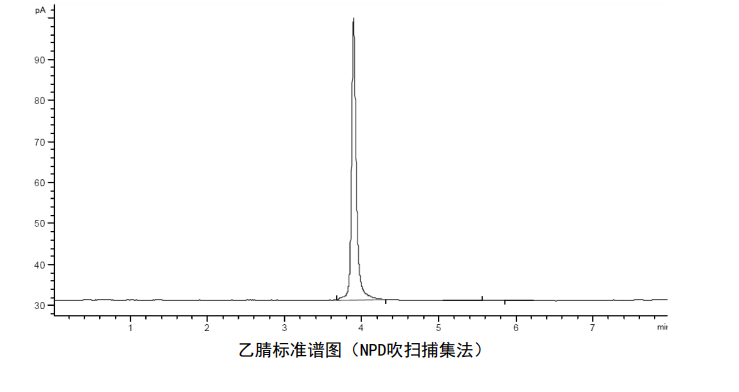Acetonitrile in surface water, groundwater, domestic sewage and other water bodies can be determined by gas chromatography. The principle of this method is as follows.
Direct injection method: The acetonitrile sample is directly injected into the gas chromatograph after filtration, separated by capillary column, detected by NPD detector, qualitative by relative retention time, and quantified by chromatographic peak area (peak height).
Purge and trap method: The sample is purged with nitrogen, the purged target is enriched through the trap tube, and then the trap tube is rapidly heated to desorb the acetonitrile adsorbed in the trap tube and enter into the gas chromatography Instrument, separated by capillary column, detected by FID or NPD detector, qualitative by relative retention time, quantitative by chromatographic peak area (peak height).
1. Acetonitrile standard stock solution: 1.00×104 mg/L.
Commercially available certified standard products, generally using water as the solvent; or using chromatographically pure standard products to prepare, first weigh a 10ml volumetric flask containing some pure water, and then drop a few drops of chromatographically pure acetonitrile 100mg (accurate to 0.1mg) , weighed. Make up to volume and mix with pure water, the concentration is about 1.00×104mg/L (accurate to 10mg/L), as the standard stock solution of acetonitrile. Stock solutions are stored in vials with Teflon screw caps and are stable for 3 months at 20-25°C.
2. Acetonitrile standard solution: 100mg/L.
Pipette a certain volume of acetonitrile standard stock solution into a 100ml volumetric flask containing some pure water, dilute to volume with pure water, and mix to obtain 100mg/L acetonitrile standard solution. The standard use liquid is ready to use.
3. High-purity nitrogen: 99.999% purity.
4. Hydrogen: purity 99.99%.
1. Purge and trap device: The purge device can be directly connected to the chromatographic part and should have a 5ml purge tube. The trap tube generally uses 1/3 Tenax, 1/3 silica gel, 1/3 activated carbon mixed adsorbent or other equivalent adsorbents.
2. Gas chromatograph: It has a capillary column split/splitless injection port, which can electronically control the carrier gas pressure. Equipped with FID or NPD detector.
3. Chromatographic column: Quartz capillary column, 30m×0.32mm×1.0μm, the stationary phase is polyethylene glycol (PEG-20M), or a chromatographic column with similar performance.
4. Air-tight syringe: 5ml.
5. Micro syringe: 5ul, 10ul, 50ul, 100ul, 500ul, 1000ul.
6. Sampling bottle: 40ml brown wide mouth sampling bottle with Teflon liner screw cap.
7. Brown glass bottles: 1ml and 2ml, with teflon-lined screw caps.
8. Balance: 1/10,000 balance.
9. Volumetric flask: Grade A, 10ml and 100ml.
In accordance with the regulations, parallel double samples are collected for all water samples, and each batch of samples should include a full program blank and a shipping blank. When collecting water samples, the water samples should overflow in the water sample bottle without leaving space.
water sample preservation
The water sample should be placed in a refrigerator at about 4°C immediately after collection, and sent to the laboratory for analysis as soon as possible. If it cannot be analyzed in time, it can be stored in a refrigerator at about 4°C. There is no organic interference in the water sample storage area, and the water sample should be completed within 7 days. analyze.
Analysis conditions of direct injection method
Reference chromatographic conditions:
Injection volume: 1.0 μl;
Injection port: splitless, temperature 220℃;
Column temperature: constant temperature 50℃;
Analysis time: 15min;
Column flow: constant flow 7.0ml/min (nitrogen);
NPD detector: temperature 330°C, hydrogen 3.5ml/min, air 80ml/min.

最新动态
相关推荐